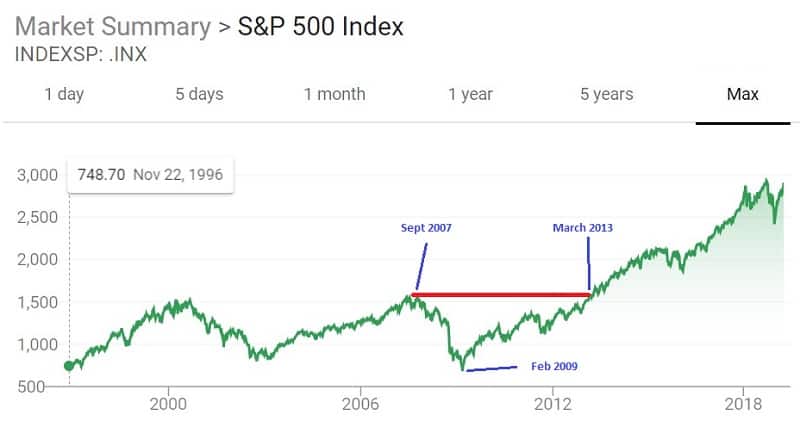We have all heard the phrase “time in the market trumps timing the market.”
That phrase simply means that timing the market is a fool’s errand. You cannot win.
It’s far more important to be invested in the market and stay invested in the market. You only start touching your investments when you need to adjust your allocations, whether for imbalances or age.
But maybe you think you’re different. Maybe you think you’ve got the touch.
I’m here to share ten investing facts that, hopefully, will cement the idea that you shouldn’t:
- Pick individual stocks,
- Try to time the market,
- Become a day trader, or,
- PANIC.
Are you ready?
Here they are:
Table of Contents
- You cannot miss the 10 best days
- Corrections are common
- Inverted yield curves are not predictive
- The best portfolios are forgotten
- Fees matter, a LOT
- Long term capital gains are awesome!
- The Great Recession “recovered” in ~6 years
- But Some Companies NEVER Recover
- Hedge funds can’t beat index funds
- When they do, they keep it to themselves!
You cannot miss the 10 best days
According to Putnam Investments, if you invested $10,000 in the S&P from the end of 2003 to the end of 2018, you’d have $30,711. That’s an annualized total return of 7.77%.
If you missed the 10 best days of the S&P 500, you’d have just $15,481. That’s an annualized total return of only 2.96%.
Missing just the ten best days cost you $15,230.
(and if you missed the 20 best days, you have a mere $10,042)
If you only invested during the 20 best days, you’d be set.
The problem is you don’t know when those 20 days are.
Market timing is the worst!
Corrections are common
From the Department of Don’t Freak Out: Corrections are common.
A correction is a 10% drop in a stock or the stock market from its most recent high.
10% isn’t a lot and “correction” is such a benign-sounding word but market pundits seem to trot it around like it’s doomsday every time they get a chance.
Did you know that between 2002 to 2021, there were 10 corrections? That’s right, 10 corrections in 20 years – 50% of the time. Despite the corrections, there were positive returns in 17 of those years with an average gain of 7%. (source)
Not all corrections turn into bear markets, which is when the market falls 20%, and bear markets are what really scare people.
And corrections always precede bear markets, because numbers are funny that way, and people always start panicking a little when we enter into a correction.
Here’s a fun chart of bull and bear markets since 1926 (up to 2018) which includes their gains/losses per year and total as well as the duration of the market.
Inverted yield curves are not predictive
If you were listening to the pundits late last year and earlier in 2019, you probably heard them mention the inverted yield curve. What this means is that in the latest Treasury bond auction, one of the shorter term bonds was priced at a higher yield than a longer term bond.
For example, in March 2019, there was an auction in which the 3-month note was priced at 2.459% and the 10-year note was priced at 2.437%. The curve had inverted!
Pundits will say that when the curve inverts, we run the risk of a recession. They are not wrong.
But, here’s the problem: it’s not predictive.
Investor’s Business Daily did the research of the 20 inversions between 1978 and 2018 (not including the most recent one).
The yield inversion can signal a recession but you don’t know when it’ll happen. Of the 20 times, in 7 cases an investor was better off selling. But in 8 cases, they were better off buying. It was a push those other five times.
It’s fun to talk about but the sky isn’t falling… yet.
The best portfolios are forgotten
I wish there was some study to cite but this one appears mostly anecdotal, but I included it because I love it so much.
In a chat between Barry Ritholtz and James O’Shaughnessy on the Masters in Business program on Bloomberg Radio, O’Shaughnessy shares a Fidelity study that showed the accounts that performed the best were the ones that were forgotten. By not touching it, by not reacting emotionally, by just leaving things along… they happened to perform quite well.
We have so many cognitive biases that mess us up – sometimes the best thing to do is leave things alone. That’s why I think of my money as being in time capsules and just leave them buried (figuratively).
Fees matter, a LOT
Let’s say you have two funds – High-Cost Index and Low-Cost Index.
They are identical except High-Cost Index has an expense ratio of 1.00% while the Low-Cost Index has an expense ratio of 0.04% (Vanguard has one just like this!).
If you contribute $100 per month for 40 years with a 7% annualized return, how much would you end up with? (DJIA compounded annual gain from 1965 to 2018 was 6.28%)
- High Cost Index Fund = $191,696
- Low Cost Index Fund = $245,953
$54,257.
You bought your broker a nice luxury car! Good for you!
Long term capital gains are awesome!
If you buy a stock and sell it within a year, you owe short term capital gains tax on it. Short term capital gains are taxed just like ordinary income, which is your federal income tax bracket.
If you own it for more than a year, you now owe long term capital gains tax on it.
Long term capital gains rates are really low. Instead of your tax bracket, you pay 0%, 15% or 20%. The long term capital gains brackets used to match the income tax brackets but after the Tax Cuts and Jobs Act, there’s a slight difference but you’ll always pay less.
For example, a single filer will pay 0% if they have income up to $39,375. They pay 15% if they have income up to $434,550. And they pay 20% if they earn over $434,550.
The point is you pay a huge penalty if you sell shares within a year. So don’t do it.
(also qualified dividends pay this same lower tax rate)
The Great Recession “recovered” in ~6 years
Check out this chart of the S&P500 during the Great Recession:

You can quibble about the definition of a recession, the exact date it starts and ends, but what most people care about is the stock market.
The peak before the recession was in September 2007, the low was in February 2009, and the S&P recovered to the peak by March 2013.
The housing bubble bursting, the banks on the verge of collapse, the job market constricting, … the list of bad economic things was endless.
And it was back to normal in less than six years.
But Some Companies NEVER Recover
The market can recover in a pretty short period of time, but some companies don’t.
J.P. Morgan Securities published a report in 2014 titled the EOTM: Special Edition by Michael Cembalest that shared a few sobering statistics about being too concentrated in individual stocks.
When you look at all the companies in the Russell 3000 index since 1980, about 40% of the stocks suffered a permanent 70% or more decline from their peak value. What goes up, must come down… and what goes down, may stay down forever.
Also another stat, since 1980, over 320 companies were removed from the S&P 500 for business distress reasons. With so much money in index funds and ETFs pegged to an index, being removed can be crushing for a company since all the funds will now sell those shares.
Diversification isn’t just for fun kids, it helps soften the inevitable catastrophic loss. Whee!
Hedge funds can’t beat index funds
Warren Buffett is no dummy. He says that most people should invest in a low cost index fund and move on. He doesn’t, because he manages billions upon billions, but for those of us with smaller accounts – simple is best.
In 2007, Warren Buffett made a one million dollar bet with then co-manager of Protégé Partners, Ted Seides, that the S&P 500 index could beat the average of five funds-of-hedge-funds picked by Ted Seides. The winner would donate the proceeds to a charity.
In 2017, Girls Inc. in Warren Buffet’s hometown received $2.22 million. They received more than the original $1 million because in 2012, both sides agreed to move the proceeds of the bet from a zero-coupon bond (that would be worth $1mm in 2017) over to shares of Berkshire Hathway.
What was the final score? In the Berkshire Hathaway 2017 shareholder letter, Buffett shared that the compounded annual return of the S&P index fund was 7.1%. The five funds of funds returned 2.2% annually.
If hedge funds can’t beat the S&P 500 index over 10 years, could you? (spoiler alert: NO!)
Oh, and actively managed mutual funds can’t beat index funds either.
When they do, they keep it to themselves!
While it’s true that most hedge funds can’t beat index funds, there are funds that do.
James Simons started a hedge fund firm, Renaissance Technologies, and their Medallion Fund had one of the most incredible runs of any fund I’d ever heard of.
“From 2001 through 2013, the fund’s worst year was a 21 percent gain, after subtracting fees. Medallion reaped a 98.2 percent gain in 2008, the year the Standard & Poor’s 500 Index lost 38.5 percent.” — Rubin and Collins. June 16, 2015. Bloomberg (from their Wikipedia page)
Here’s the thing – it’s closed to new investors and only available to current and past employees and their families.
Hmmmm… interesting, right?
Which of these facts or statistics genuinely surprised you?



